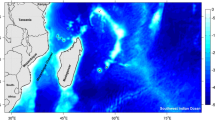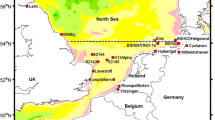Abstract
The Bohai Sea is extremely susceptible to storm surges induced by extratropical storms and tropical cyclones in nearly every season. In order to relieve the impacts of storm surge disasters on structures and human lives in coastal regions, it is very important to understand the occurring of the severe storm surges. The previous research is mostly restricted to a single type of storm surge caused by extratropical storm or tropical cyclone. In present paper, a coupled atmosphere-ocean model is developed to study the storm surges induced by two types of extreme weather conditions. Two special cases happened in the Bohai Sea are simulated successively. The wind intensity and minimum sea-level pressure derived from the Weather Research and Forecasting (WRF) model agree well with the observed data. The computed time series of water level obtained from the Regional Ocean Modeling System (ROMS) also are in good agreement with the tide gauge observations. The structures of the wind fields and average currents for two types of storm surges are analyzed and compared. The results of coupled model are compared with those from the uncoupled model. The case studies indicate that the wind field and structure of the ocean surface current have great differences between extratropical storm surge and typhoon storm surge. The magnitude of storm surge in the Bohai Sea is shown mainly determined by the ocean surface driving force, but greatly affected by the coastal geometry and bathymetry.
Similar content being viewed by others
References
Bruneau N, Toumi R. 2016. A fully-coupled atmosphere-ocean-wave model of the Caspian Sea. Ocean Modelling, 107: 97–111, doi: 10.1016/j.ocemod.2016.10.006
Cha D H, Wang Yuqing. 2013. A dynamical initialization scheme for real-time forecasts of tropical cyclones using the WRF model. Monthly Weather Review, 141(3): 964–986, doi: 10.1175/MWR-D-12-00077.1
Charnock H. 1955. Wind stress on a water surface. Quarterly Journal of the Royal Meteorological Society, 81(350): 639–640
Choi B H, Kim K O, Eum H M. 2002. Digital bathymetric and topographic data for neighboring seas of Korea. Journal of Korean Society of Coastal and Ocean Engineers, 14(1): 41–50
Ding Yumei, Ding Lei. 2014. A numerical simulation of extratropical storm surge and hydrodynamic response in the Bohai Sea. Discrete Dynamics in Nature and Society, 2014: 282085
Ding Yumei, Wei Hao. 2017. Modeling the impact of land reclamation on storm surges in Bohai Sea, China. Natural Hazards, 85(1): 559–573, doi: 10.1007/sll069-016-2586-4
Feng Xingru, Yin Baoshu, Yang Dezhou, et al. 2011. The effect of wave-induced radiation stress on storm surge during Typhoon Saomai (2006). Acta Oceanologica Sinica, 30(3): 20–26, doi: 10.1007/S13131-011-0115-6
Fu Cifu, Dong Jianxi, Wu Shaohua, et al. 2011. Numerical simulation on typical extratropical storm surge in the Bohai Sea. Marine Forecasts (in Chinese), 28(5): 1–8
Fu Cifu, Yu Fujiang, Wang Peitao, et al. 2013. A study on extratropical storm surge disaster risk assessment at Binhai New Area. Haiy-ang Xuebao (in Chinese), 35(1): 55–62
Fu Cifu, Fu Xiang, Wu Shaohua, et al. 2014. Numerical simulation study on deepwater channel influenced by negative storm surge and its features in Bohai Sea. Haiyang Xuebao (in Chinese), 36(3): 30–38
Guan Hao, Zhou Lin, Xue Yanguang, et al. 2012. An applied study on the atmosphere-ocean-wave coupled model in the South China Sea. Journal of Tropical Meteorology (in Chinese), 28(2): 211–218
Haidvogel D B, Arango H, Budgell WP, et al. 2008. Ocean forecasting in terrain-following coordinates: formulation and skill assessment of the regional ocean modeling system. Journal of Computational Physics, 227(7): 3595–3624, doi: 10.1016/j.jcp. 2007.06.016
Hsiao L F, Liou C S, Yeh T C, et al. 2010. A vortex relocation scheme for tropical cyclone initialization in advanced research WRF. Monthly Weather Review, 138(8): 3298–3315, doi: 10.1175/ 2010MWR3275.1
Kong Xiangpeng. 2014. A numerical study on the impact of tidal waves on the storm surge in the north of Liaodong Bay. Acta Oceanologica Sinica, 33(1): 35–41, doi: 10.1007/sl3131-014-0430-9
Kurihara Y, Bender M A, Tuleya R E, et al. 1995. Improvements in the GFDL hurricane prediction system. Monthly Weather Review, 123(9): 2791–2801, doi: 10.1175/1520-0493(1995)123<2791:IIT-GHP>2.0.CO2
Li Darning, Li Yangyang, Pan Fan. 2015. Coupling model of 2-D variable zone storm surge and waves for Bohai Bay. Journal of Shanghai Jiaotong University (in Chinese), 49(5): 730–736
Li Darning, Xu Yanan, Song Shuangxia, et al. 2010. The study on the effect of wave-radiation stress on storm surge in Bohai Bay. Journal of Hydrodynamics (in Chinese), 5(3): 374–382
Li Yong, Chen Xin, Tian Lizhu, et al. 2017. Numerical simulation of the storm surge in Bohai Bay based on a coupled ocean-atmosphere model. Journal of Shanghai Jiaotong University (in Chinese), 51(12): 1512–1519
Li Yong, Tian Lizhu, Pei Yandong, et al. 2016. Numerical simulation of storm surge inundation in the west zone of Bohai Bay. Geological Bulletin of China (in Chinese), 35(10): 1638–1645
Lim H S, Kim C S, Park K S, et al. 2013. Down-scaled regional ocean modeling system (ROMS) for high-resolution coastal hydrodynamics in Korea. Acta Oceanologica Sinica, 32(9): 50–61, doi: 10.1007/sl3131-013-0352-y
Liu Na, Ling Tiejun, Wang Hui, et al. 2015. Numerical simulation of Typhoon Muifa (2011) using a coupled ocean-atmosphere-wave-sediment transport (COAWST) modeling system. Journal of Ocean University of China, 14(2): 199–209, doi: 10.1007/ S11802-015-2415-5
Liu Yang, Lin Wenshi, Li Jiangnan, et al. 2017. A numerical simulation of latent heating within Typhoon Molave. Acta Oceanologica Sinica, 36(7): 39–47, doi: 10.1007/sl3131-017-1082-3
Mo Dongxue, Hou Yijun, Li Jian, et al. 2016. Study on the storm surges induced by cold waves in the Northern East China Sea. Journal of Marine Systems, 160: 26–39, doi: 10.1016/j.jmarsys. 2016.04.002
Nguyen H V, Chen Y L. 2010. WRF simulation of a TC-induced recored-breaking heavy rainfall event over Taiwan. In: Proceedings of the Fifth International Ocean-Atmosphere Conference. Taipei: Chinese-American Oceanic and Atmospheric Association (COAA)
Olabarrieta M, Warner J C, Armstrong B, et al. 2012. Ocean-atmosphere dynamics during Hurricane Ida and Norolda: an application of the coupled ocean-atmosphere-wave-sediment transport (COAWST) modeling system. Ocean Modelling, 43–44: 112–137, doi: 10.1016/j.ocemod.2011.12.008
Skamarock W C, Klemp J B, Dudhia J, et al. 2008. A description of the advanced research WRF version 3. USA: National Canter for Atmospheric Research
Sun Minghua, Duan Yihong, Zhu Jianrong, et al. 2014. Simulation of Typhoon Muifa using a mesoscale coupled atmosphere-ocean model. Acta Oceanologica Sinica, 33(11): 123–133, doi: 10.1007/S13131-014-0561-Z
Sun Wenxin, Feng Shizuo, Qin Zenghao. 1979. Numerical modeling of an ultra-shallow water storm surge (I). Haiyang Xuebao (in Chinese), 1(2): 193–211
Sun Wenxin, Feng Shizuo, Qin Zenghao. 1982. Numerical study on the Bohai Sea wind surges-the zeroth-order dynamical model. Acta Oceanologica Sinica, 1(2): 175–188
Wang Yangjie, Zhang Qinghe, Chen Tongqing, et al. 2016. Application of a coupled atmosphere-ocean-wave model in typhoon process simulation. Journal of Waterway and Harbor (in Chinese), 37(2): 135–141
Warner J C, Armstrong B, He Ruoying, et al. 2010. Development of a coupled ocean-atmosphere-wave-sediment transport (COAWST) modeling system. Ocean Modelling, 35(3): 230–244, doi:10.1016/j.ocemod.2010.07.010
Warner J C, Perlin N, Skyllingstad E D. 2008. Using the Model Coupling Toolkit to couple earth system models. Environmental Modelling & Software, 23(10–11): 1240–1249, doi: 10.1016/j. envsoft.2008.03.002
Wu Shaohua, Wang Xinian, Dai Mingrui, et al. 2002. The general status of storm surges and the simulation of extratropical storm surges in the Bohai Sea. Haiyang Xuebao (in Chinese), 24(3): 28–34
Zambon J B, He Ruoying, Warner J C. 2014. Investigation of hurricane Ivan using the coupled ocean-atmosphere-wave-sediment transport (COAWST) model. Ocean Dynamics, 64(11): 1535–1554, doi: 10.1007/sl0236-014-0777-7
Zhao Peng, Jiang Wensheng. 2011. A numerical study of storm surges caused by cold-air outbreaks in the Bohai Sea. Natural Hazards, 59(1): 1–15, doi: 10.1007/sll069-010-9690-7
Acknowledgements
We are grateful to NCAR, which is responsible for the WRF model. The authors are also grateful to Rutgers University and University of California at Los Angeles (UCLA), which are responsible for the ROMS model. Furthermore, the open-source package named ‘wrf_roms-1.2.tar.gz’ provides a favorable technique foundation for developing WRF-ROMS coupling system. The MCT is accessible from http://www.mcs.anl.gov/research/projects/mct and the SCRIP can be obtained from http://oceans11.lanl.gov/trac/SCRIP. The ERA-Interim/ECMWF reanalysis data used in present work is available from https://www.ecmwf.int/en/forecasts/datasets/reanalysis-datasets/era-interim.
Author information
Authors and Affiliations
Corresponding author
Additional information
Foundation item: The National Natural Science Foundation of China under contract Nos 41372173 and 51609244; the Geological Survey Projects of China Geological Survey under contract No. 121201006000182401.
Rights and permissions
About this article
Cite this article
Li, Y., Chen, X., Jiang, X. et al. Numerical simulations and comparative analysis for two types of storm surges in the Bohai Sea using a coupled atmosphere-ocean model. Acta Oceanol. Sin. 38, 35–47 (2019). https://doi.org/10.1007/s13131-019-1383-9
Received:
Accepted:
Published:
Issue Date:
DOI: https://doi.org/10.1007/s13131-019-1383-9




